Hyundai Tucson Vs Ford Escape: Which Crossover is Right for You?

Want a compact crossover, but one that will stand out in the most popular segment on the market? The Hyundai Tucson and Ford Escape both fit the bill.
These two cute utes are less common than the sales-leading Toyota RAV4 and Honda CR-V. Both offer the form factor buyers crave, along with available all-wheel drive and hybrid options to broaden their appeal.
Both of these nameplates have been around for a while, but they’ve gone in very different directions in their latest iterations. Will the car-like Blue Oval offering sway you, or is the tech-laden Tucson more up your alley? Let’s find out.
Cabin Space
Tucson: With the current generation Tucson debuting for the 2022 model year, Hyundai has stretched out its compact crossover. The wheelbase now measures 108.5 inches (2,755 mm), contributing to a healthy 41.4 and 41.3 inches of leg room front and back (1,052 and 1,050 mm, respectively). Head room in lower trims is 40.1 inches (1,019 mm) up front, and 39.4 inches (1,002 mm) for rear-seat passengers. Higher trims gain a panoramic sunroof, which cuts those numbers down to 38.1 and 39.0 inches (968 and 990 mm). Yes, the front row has less than the rear there.
Get a Quote on a New Hyundai Tucson or Ford EscapeShoulder room is 57.6 inches (1,464 mm) in front, with 54.5 inches (1,385 mm) of hip room. Rear space is naturally at a premium, but not by much: the numbers there are 56.0 and 53.9 inches (1,422 and 1,369 mm).
Hybrid models shave a small 0.3 inches (7 mm) off the rear-seat head room, thanks to under-seat battery storage.
Escape: Despite a smaller 106.7-inch (2,710-mm) wheelbase, the model in the blue corner comes out on top in the leg room race. Stretch those feet out: you’ve got 42.4 inches (1,077 mm) up front, and 40.7 inches (1,034 mm) in back. Ford quotes an even 40.0 inches (1,016 mm) of head space for the driver and whomever rides shotgun, with a slight decrease to 39.3 inches (998 mm) in the second row. However, we know not all models come with a panoramic sunroof, so this number isn’t accurate for all trims.
Shoulder room is practically tied here: the Escape has a single mm less up front, but that still rounds to 57.6 inches, and the rear shoulder room is an identical 56.0 inches (1,422 mm). The Escape offers more hip room up front (55.2 inches / 1402 mm), but less in the second row (53.3 inches / 1354 mm).
There is a hybrid-based measurement difference for the Ford, too. Opting for battery assistance eats into second-row legroom, which drops to a still-adequate 38.9 inches (988 mm).
SEE ALSO: 2020 Ford Escape Hybrid Review: Friendly Fuel-SipperBottom Line: Seldom have we seen such similar measurements between two unrelated models. Both of these compact crossovers come within an inch of each other when the tape is out. We recommend sitting in both—with and without the big glass roofs—to know how you really fit.
Cargo Space and Towing
Tucson: Hyundai quotes a handy 38.7 cubic feet (1,096 L) of seats-up trunk space, over doubling to 80.3 cubes (2,274 L) when the second row is flat. Hybrid models see a bit of a dip, but only in two-seat configuration, at 74.5 cubic feet (2,110 L).
All Tucsons can tow up to 2,000 lb (907 kg) when properly equipped..
SEE ALSO: 2020 Kia Telluride vs 2019 Subaru Ascent: Three-Row ThrowdownEscape: With the second-row seats in their most storage-friendly setting while still holding people, you’ll find 37.5 cubic feet (1,062 L). Fold them down and there’s 65.4 cubic feet (1,852 L). The hybrid models offer 34.4 and 60.8 cubes (974 and 1,722 L), respectively.
Ford quotes a 1,500 lb (680 kg) towing limit for the hybrid models. The 1.5-liter gas model posts a Tucson-matching 2,000 lb (907 kg). Meanwhile the 2.0-liter turbocharged model muscles out to a full 3,500 lb (1,587 kg).
Bottom Line: There’s no two ways about it: the Tucson offers more storage space in every possible format. The two are pretty even on towing too, though if have the dual needs of a compact footprint and heavier towing, only the 2.0-liter EcoBoost Escape will suffice.
Technology and Features
Tucson: Every Tucson comes standard with a touch screen measuring at least 8.0 inches. In fact, the smaller screen offers a nice perk over the larger 10.25-inch one: wireless Android Auto and Apple CarPlay. HD Radio is also standard, as are six speakers. Keyless entry, a driver’s auto up/down window, two USB slots, and 17-inch alloy wheels are also part of the Tucson SE package. Busy parents will appreciate the stain- and odor-resistant cloth seating, too.
The SEL adds another pair of USB outlets in the second row. A power driver’s seat is also included, with heating. Hyundai’s BlueLink connected car system is part of the package, while the exterior gains LED lighting. The optional Convenience Package adds a hands-free power liftgate, 19-inch alloys, power sunroof, a fully digital instrument cluster, wireless charger, ambient lighting, dual-zone auto climate control, and more. The Premium Package brings in leather seating, a Bose audio system, and some exterior tweaks.
On top of that, the Limited adds a huge glass roof, voice recognition, a power-adjustable passenger seat, driver’s memory seat function, heated rear seats, larger infotainment, 360-degree camera, and Hyundai’s “Smaht Pahk” system.
Escape: You’ll find an 8.0-inch infotainment screen in the Escape as well, running SYNC 3—but you’ll need to opt for the SE for it. Both types of USB ports come standard in the base S, and there’s even one on the back of the center console. Other standard S features include 17-inch alloy wheels, a 4G LTE WiFi hot spot, voice recognition, and keyless entry.
The SEL is the sweet spot of the Escape range, bringing in dual-zone auto climate control, bucket seats with ActiveX easy-clean material, heated front seats, and a 10-way power adjustable driver’s perch. Full LED lighting is also included, as is Ford’s unique SecuriCode keypad system.
Titanium buyers will find 19-inch alloys, ambient lighting, a 12.3-inch digital instrument panel, and auto-dimming rearview mirror. A memory function is available not just for the driver’s seat, but the passenger too. A 10-speaker Bang & Olufsen sound system pumps up the jams. Spec the Elite Package and you’ll find leather seating, a panoramic sunroof, head-up display, and more.
Bottom Line: As is the case in the other categories, there’s little clear space between these two. Being the newer of the two, the Tucson is better equipped to start, especially with the wireless connectivity. The available Digital Key is another huge boon.
Powertrains
Tucson: There are three engine options available for the current Tucson. Sticking to purely ICE propulsion nets buyers a 2.5-liter naturally-aspirated four-cylinder, producing 187 horsepower and 178 lb-ft of torque. An eight-speed automatic is the only transmission; front-wheel drive is standard, while AWD is optional.
Moving into the hybrid model trades the 2.5-liter for a smaller, 1.6-liter turbocharged unit. An electric motor augments the four-cylinder for a combined system total of 227 hp, with 258 lb-ft of max torque. The electric motor draws from a 1.49-kWh battery under the rear seats. In an unusual move for hybrids, Hyundai has fit the Tucson with a six-speed auto instead of a CVT. AWD is standard on the hybrid.
There is also a plug-in version of the hybrid, which uses a stronger electric motor for 261 hp, and a larger battery as well (13.8 kWh).
Escape: The Escape lineup starts with a 1.5-liter three-cylinder EcoBoost. It’s down on power versus the Tucson at 181 hp, but boasts more torque (190 lb-ft), and across a wider band of the rev range. Like the Hyundai, the Ford uses an eight-speed auto, with either front- or all-wheel drive. Higher trims offer the more powerful 2.0-liter turbo four-cylinder, producing 250 hp and 280 lb-ft of torque. This engine is only available with AWD.
Hybrid models use a 2.5-liter naturally-aspirated four-cylinder—sound familiar?—hooked up to a CVT. An electric motor teams with the ICE for a combined 200 hp. The battery pack is a small 1.1-kWh unit. The Escape is the only compact crossover hybrid to come in either front- or all-wheel drive.
You’ll have no such choice for the plug-in version, which is front-drive only. It uses a larger 14.4-kWh battery pack, and is rated to the same 200 combined hp.
Bottom Line: The base engines are remarkably similar here. If you can swing the added cost, we recommend the hybrids over both base engines, with more power and better fuel economy. The Hyundai holds the edge here in terms of driving refinement, all due to that six-speed auto. Meanwhile, if outright power is what you crave, only the Escape 2.0 EcoBoost will suffice.
Fuel Economy
Tucson: The EPA rates the front-drive gas-only Tucson at 26 mpg city, with a 33 mpg highway rating. Combined, it posts a 29 mpg score. AWD models sees those numbers drop to 24, 29, and 26 mpg, respectively.
The hybrid model naturally sips less fuel. Stick to its base Blue trim and you’ll find 38 mpg across the board; move up to the others and the Tucson scores 37 mpg city, 36 mpg highway, and 37 mpg combined.
Plug-in hybrid EPA figures were unavailable at the time of writing. We know it will run 28 miles on nothing but electrons, however.
Escape: The most fuel-efficient non-hybrid Escape is, surprise surprise, the 1.5-liter front-drive model. The EPA rates it at 28 mpg city and 34 mpg highway, for an average of an even 30 mpg. Ticking the AWD box drops 2 mpg off the city and average numbers, and 3 mpg from the highway rating. The 2.0-liter EcoBoost, available only with AWD, posts 23/31/26 mpg, respectively.
Opt for a front-drive hybrid Escape and the EPA says it’ll crack 44 mpg in the city. A 37 mpg highway figure results in a 41 mpg combined rating, the very best rating in the compact crossover segment. The second-best model? The AWD Escape hybrid, which drops to 40 mpg combined thanks to a 1 mpg hit to its city rating.
The plug-in hybrid will hit 40 mpg combined when running on gas only, and has a 105 mpg-equivalent rating. Its all-electric range is around 38 miles per charge.
Bottom Line: Any way you slice it, the Ford takes the win here. Even its most powerful engine essentially matches the Tucson’s one gas model, and the gap remains on the hybrids. We expect the plug-in hybrid match-up to go the same way, though in the Hyundai’s defence, it does come with standard AWD there.
Safety
Tucson: Neither the NHTSA nor IIHS have scored the 2022 Tucson at the time of writing. The previous model earned a 5-star rating from the former though, and a Top Safety Pick title from the latter.
Standard driver and safety assists include automated emergency braking, automatic on/off LED headlights, lane keep and follow assists, and high beam assist. The SEL trim adds blind spot monitoring, rear cross-traffic alert, safe exit assist, and adaptive cruise control. Limited trims add a 360-degree camera, rear parking sensors, blind-spot view monitor, rain-sensing wipers, and Highway Driving Assist.
Escape: Even the lowest Escape S trim comes equipped with Ford’s Co-Pilot360 suite of assists, including auto high beams, blind spot monitoring with cross-traffic alert, lane keep assist, auto on/off headlights, and automated emergency braking with pedestrian detection. The optional Co-Pilot360 Assist+ package on the SE and SEL adds an evasive steering assist feature, voice-activated native navigation, and adaptive cruise control. The SEL also includes a reverse sensing system. Titanium models include rain-sensing wipers, speed sign recognition, and Ford’s own parking assist.
The Escape aces the NHTSA testing regimen, scoring a full 5 stars in all categories bar rollover (4 stars). Meanwhile, the IIHS gives the Blue Oval crossover a Top Safety Pick rating.
Bottom Line: The Escape holds the advantage off the bat, with blind spot monitoring and cross-traffic alert present even on the base model. Moving up through the trims the advantage disappears, as the volume models need an option package included to match the Tucson. The Tucson gains the upper hand in top trim form, thanks to a 360-degree camera and the blind-spot view monitor.
Styling
Tucson: Drawing inspiration from 2019’s Vision T concept, the Tucson looks unlike anything else on the road. Well, except the upcoming Santa Cruz compact pickup, which borrows much of its front-end design. It’s the nose that gets a lot of the attention here; Hyundai’s designers have cleverly hidden the lighting within the elements of the grille, only giving the Tucson its “face” when lit. Other eye-catching features include a full-width LED bar connecting the taillights, and the textured chrome D-pillar, which echoes a design found on the wheel arches.
Edgy and angular, the Tucson cuts a striking profile, and manages to look at home in and out of the city.
Escape: Ford has gone the opposite direction of most of the segment with the pebble-smooth styling of the current Escape. With the rough-and-tumble Bronco Sport serving as a slightly smaller off-roader, the Escape has leaned into the role most folks use it for: regular car stuff. It has a friendlier face than the futuristic Tucson, no doubt due to the big smile of a grille. The flanks are another stark contrast: there’s barely a crease to be found, instead of the origami-like sides of the Tucson.
The Escape looks like a slightly enlarged family hatchback because really, that’s what most compact crossovers are these days.
Bottom Line: Your tastes will determine the winner in this section: concept car edginess, or smooth and curvy?
Pricing
Tucson: The Tucson lineup kicks off with the $26,135 SE trim in front-drive form, including destination. Next up the ladder is the value-packed SEL, which comes with an MSRP of $27,685. It offers two option packages: the $2,600 Convenience Package, and the $1,700 Premium Package, which requires the former. The sporty N-Line sits in the middle of the walk, priced from $31,785. Finally, at the top of the gas-only range sits the $35,885 Tucson Limited.
Adding AWD to any of the 2.5-liter trims bumps the asking price up by $,1400.
AWD is standard on the hybrid models, the Blue being the most affordable at $30,235. The SEL Convenience is next at $32,835, and those wanting the absolute top Tucson trim will find the Hybrid Limited at $38,535. For reference, that’s just $1,250 more than the conventionally-powered Limited AWD.
Escape: Want to talk close competition? The Escape lineup begins at $26,130, a mere $5 away from the Tucson. The gap grows to $170 with the $27,855 Escape SE. The SE is available with a Convenience Package ($985) and the upgraded Ford Co-Pilot360 Assist+ package ($700).
The penultimate SEL trim is roughly equivalent to the optioned-out Tucson SEL, ringing in at $30,450. All-wheel drive is an extra $1,500 on all three trims, and required on the SEL to upgrade to the 2.0-liter EcoBoost (an additional $3,195 charge). The Co-Pilot360 package is also available here.
The top Titanium trim is an even $37,000, and that includes the standard AWD. A spendy $2,850 Elite Package adds a head-up display, perforated leather seating, panoramic roof, wireless charger and more.
Hybrid shoppers will find a similar model walk, going from SE ($28,850), SEL ($31,445), and Titanium ($34,545). AWD is once again a $1,500 upcharge here, but not on the plug-in hybrid models, which start from $33,895 for an SE and stretch to $39,830 for a Titanium.
Bottom Line: From the entry point to the mid-level volume trims, pricing is pretty even in this American-Korean face-off. The Tucson offers a price advantage on the top trims, though.
In Conclusion
Both the Hyundai Tucson and Ford Escape are well-equipped, comfortable family cruisers. There’s little separating them in terms of price, as well. The Escape is the more car-like of the two, not only in its looks, but with its better fuel economy figures. The very top trims can get spendy, however, and even then, it never comes with significantly better equipment than the Tucson. The Tucson offers more space and more toys, and while its hybrid can’t match the Escape’s mpgs, we’d take that hit for the more enjoyable drive. The Tucson is our pick here.
Become an AutoGuide insider. Get the latest from the automotive world first by subscribing to our newsletter here.

Kyle began his automotive obsession before he even started school, courtesy of a remote control Porsche and various LEGO sets. He later studied advertising and graphic design at Humber College, which led him to writing about cars (both real and digital). He is now a proud member of the Automobile Journalists Association of Canada (AJAC), where he was the Journalist of the Year runner-up for 2021.
More by Kyle Patrick




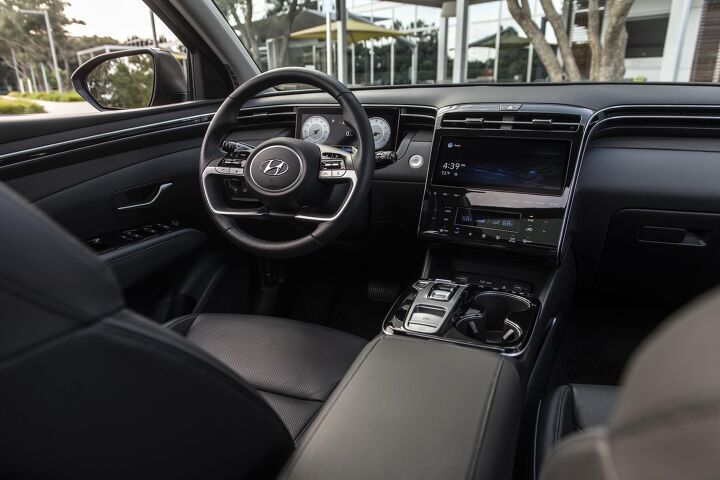


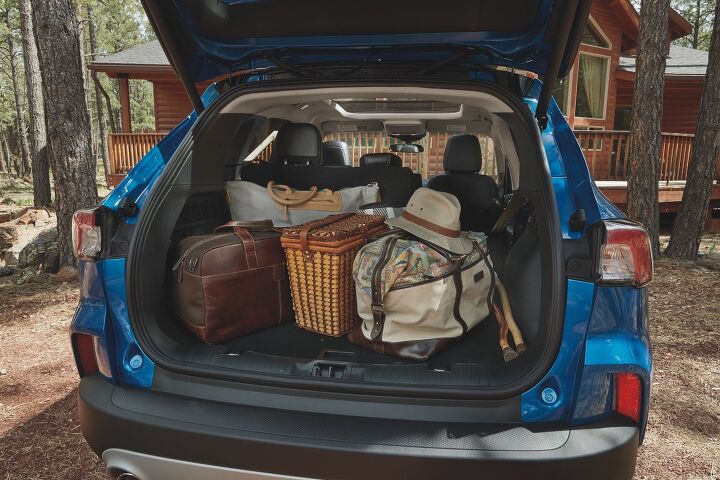
























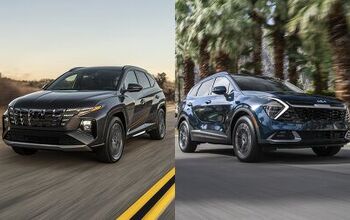

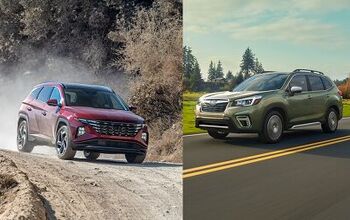
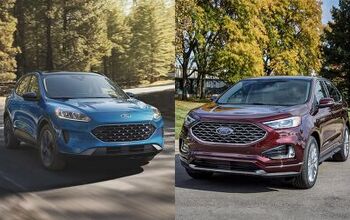
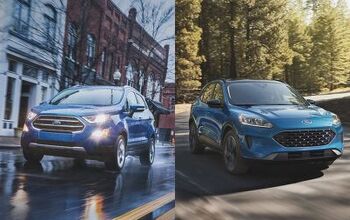


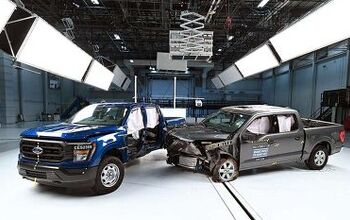


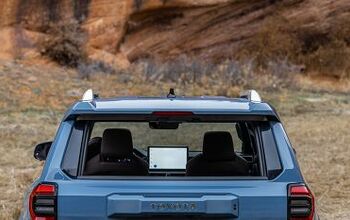

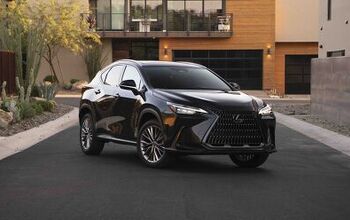

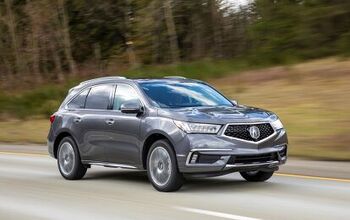
Comments
Join the conversation